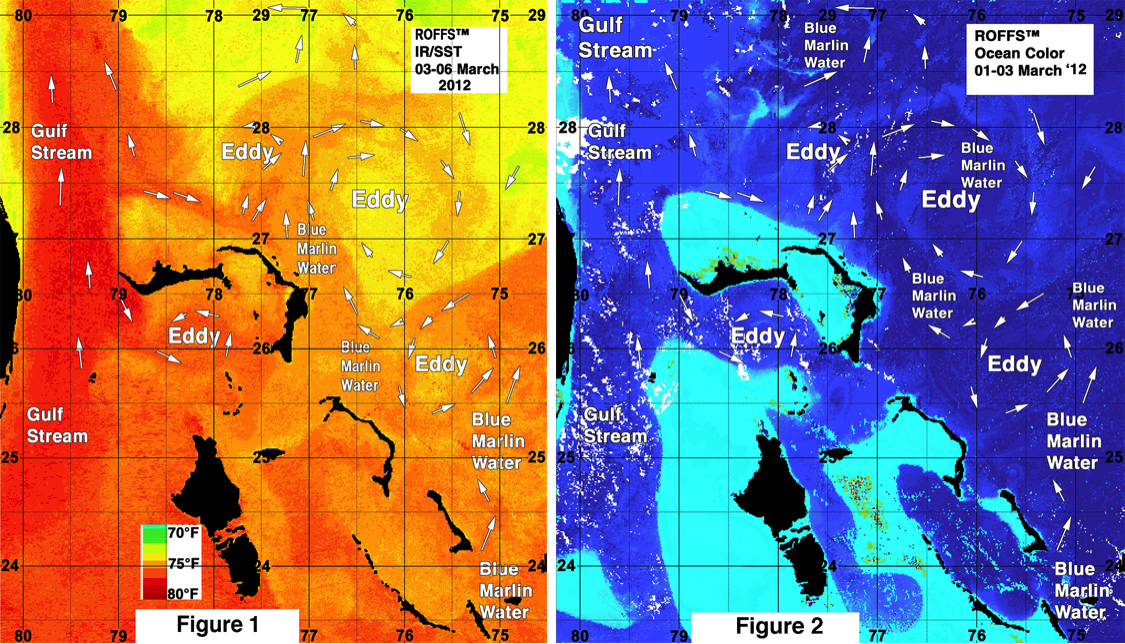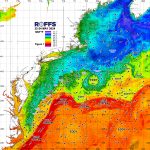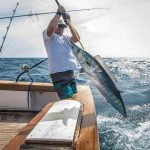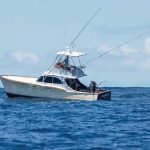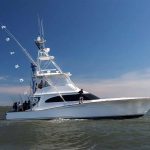Please click HERE to download this article as a PDF.
Introduction:
Since 2003 we have been developing objective methods for forecasting the overall fishing action during the April-June Bahamas Billfish Championship (BBC) tournament season. The hypothesis for forecasting the seasonal marlin fishing action stems from the location and geographic extent of the bluer and often warmer water that occurs from the Cat Island – San Salvador Island area and south where it is presumed that the marlin concentrate before, during, and after spawning. We have been calling this water “blue marlin water.” From satellite data it is relatively easy to identify this water based on its signature optical and surface water temperature characteristics. Our working hypothesis is that the marlin are associated with this water and the more “blue marlin water” that exists in the Abaco Islands and Eleuthera Island areas, the greater the relative apparent abundance of marlin in these areas. Also in recent years we have observed an association between this water and the yellowfin tuna action in the Bahamas, as well as, along the western side of the Gulf Stream between Jacksonville, Florida and Cape Hatteras, North Carolina. This also seems to be holding true for the canyon areas northeast to Massachusetts when the blue water is brought to the edge of the continental shelf (100 fathoms/600 feet) starting in April. But as this article is focused on the blue marlin and the Bahamas, the discussion related to yellowfin tuna and bigeye tuna, the overfishing off west Africa, changes in dissolved oxygen, and catch rates off the United States east coast will have to wait for another article as we have time over the next few weeks and months.
Based on our observations of the fishing action and ocean conditions in the Bahamas, particularly from Eleuthera to the Abacos over the last 20+ years it appears that excellent fishing action overall occurs within the BBC tournament area when there is a substantial volume of the “blue marlin water” pushing over the 100 fathom (600 feet, 200 meters) and shallower ledges along the eastern side of Eleuthera and the Abacos. Relatively good fishing seasons occur when this water only occurs over the 500-1000 fathom depths, but does not reach the 100 fathom and shallower depths of both areas. Mediocre years occur when there is a lack of this water over these areas. Short pulses of this water bring fish into the area along with pulses of fishing action. However, unless the flow is persistent, the catch rates remain so-so over the longer term.
It is also important to understand that good fishing action on a daily basis is linked to the favorable direction of these currents and when the water mass boundaries of these currents are stable for three to five consecutive days over good bottom topography that normally concentrate the prey fish. For the BBC tournament areas, the dissolved oxygen concentration does not appear to be a major factor at the present time compared with the temperature and clarity of the water. In other areas south, the dissolved oxygen has a greater controlling factor on fish distribution both vertically and horizontally. The themes of declining dissolved oxygen levels and changing pH of the oceans is something we are monitoring closely.
The BBC working hypothesis is based on our experience using the hourly satellite observations of the ocean conditions derived by Roffer’s Ocean Fishing Forecasting Service, Inc. – ROFFS™ (roffs.com) and catch reports provided by a variety of sources over 25+ years. The infrared (IR) satellite data are used to observe the sea surface temperature (SST) and the ocean color data are used for indices of phytoplankton (chlorophyll), water clarity, and colorized dissolved organic material are received from a variety of sources including NASA, NOAA, Suomi National Polar-orbiting Partnership (SNPP or JPSS), and the European Space Agency (ESA) satellites. ROFFS™ also uses data derived from drifting buoys, gliders, aircraft, private boats, and satellite altimeters. The altimeter data only provide a very coarse spatial and temporal resolution with a time delay (5-10 days to produce usable circulation models) that limits the data’s utility related to high resolution and real-time operational oceanography. While the ocean changes significantly over such short periods, the altimeter data can be used for an overall, albeit 5-10 day average view of the ocean’s surface circulation. It is not useful for evaluating small scale, short-term (daily and sub-daily) changes in the ocean currents or their boundaries.
During the last several years we had observed that the conditions over the BBC tournament area were particularly favorable as early as January to the first week in March in terms of the presence of “blue marlin” water off Abaco and Eleuthera as exemplified by the first week in March 2012 (Figures 1 & 2).
Please click image above for a larger version.
As stated earlier, the critical aspect for having a good blue marlin season is the presence of the blue marlin water pushing over the 100 fathom curve creating persistent convergence zones for food to concentrate. Figures 1 and 2 show the distribution of the “blue marlin” water prior to the 2012 BBC season. Figure 1 was derived over the March 03-06, 2012 period using a variety of IR satellite data from NOAA, NASA, and ESA that shows the water masses based on their signature sst. Figure 2 is an ocean color image that was derived from NASA and ESA satellites over March 01-03, 2012 that shows the water masses based on their signature ocean color. Clouds prevented us from providing an exact match in time due to the clouds associated with the strong cold front that stalled over the Bahamas during this period. However, using a variety of computer techniques ROFFS™ was able to remove many of the interfering clouds to allow a one day overlap of the imagery to provide a better comparison. The darker blue water is the “blue marlin” water.
During the actual 2011, 2012, 2013, 2014, and 2015 Bahamas tournament fishing seasons the “blue marlin” water existed in the tournament areas, only to be pulled away from the BBC tournament area by the ocean currents forced by various eddy features (60-120 miles in diameter) that occurred east and northeast of Abaco. Some good fishing action happened during these years due to the intermittent arrival of the “blue marlin” water and the presumed migration of the fish through the area. Unfortunately, the favorable conditions were not persistent throughout the entire tournament season like some of the banner years in the 1990’s and early 2000’s. We do not know if this is represents a circulation regime shift in the region, but only time will tell. Our experience suggests that variability is the norm, but this is something that an longer term automated altimeter study could resolve.
Background and Some Data for 2016
Although we have learned that the actual tournament conditions develop from the presence, absence or mixture of the “blue marlin” water, we continue to follow the tradition of preparing the forecast from first week in March. This allows us to gain insight into the conditions prior to the tournament. One of the challenges of producing a such an early forecast is that these exciting, entertaining, and fun fishing events extend over a relatively long time period from the end of April or first week of May through the third or fourth week of June. This year (2016) the first BBC tournament starts May 4th at Guana Cay. Conditions are likely to change dramatically from one fishing event to the next without any scientifically proven and field-tested methods to predict the changes over the period from March through June. Sorry, there still are no reliable numerical oceanographic models to use to make accurate and reliable high resolution localized oceanographic forecasts that extend for several days, never mind the entire season. ROFFS™ is working with other oceanographers to develop improved ocean and climate models, so perhaps next year our task for the seasonal forecast will be easier.
For forecasting short-term oceanographic conditions related to finding fish at ROFFS™ we generally believe that the conditions observed now are the ones likely to continue into the short-term future (days) unless we can see the mechanisms (currents) that would drive the changes. For some this is known as the persistence and climatology technique of forecasting. While we have two crystal balls in our office for forecasting, we prefer to use real data and we have learned that evaluating the preseason conditions annually provides insight into future seasonal trends. Experience is our guide as we have had moderate success in forecasting seasonal trends of fishing productivity based on the location, condition, and likely future changes of the fishes’ preferred habitat in time and space for a variety of species over many areas of the world.
In the case of the BBC tournament season we derive our first indications during the first week in March in that whether or not we are observing “normal” (climatologically mean conditions) or anomalies. For this we rely on satellite data and a climate models from some of the experts in the field. One indication is sea surface temperature (SST) in the core of the Gulf Stream off Miami and the SST of the Bahamas blue marlin water east of Cat Island. Because we started our forecasting studies during the first week of March in 2003 we have continued our time series using that week.
The ROFFS™ 13 year (2003-2015) mean SST for the core of the Gulf Stream off Miami is 78.4°F during our standard March 05-06, 2016 measurement period. The SST has been as low as 74.8°F (2009) to a high of 80.5°F (2007) and we have not observed any overall trends as of yet, unlike other areas such as in New England (increasing). Climate variability and change is not evenly distributed. This year the SST was 78.4°F in the Gulf Stream off Miami on March 05 and 6th (2016). While have not been recording the SST of the Bahamas “blue marlin” water off Cat Island as long, the eight year mean (2008 – 2015) SST for the warmer water east of Cat Island area is 76.4°F. Unlike last year which was 78.6 the warmest year to date for our limited data set, this year the SST was 76.7°F. Neither the Miami or Cat Island values are statistically different from the average indicating that we are in the mist of an “average” year, i.e. nothing unusual in terms of surface water temperature.
The global, hemispheric and regional climate models also provide guidance into the present and future conditions. We usually use the climate data, analyses, and forecasts provided by Columbia University’s International Research Institute (IRI) for Climate and Society (http://iri.columbia.edu), NOAA’s Climate Prediction website (http://www.cpc.ncep.noaa.gov), and the National Center for Atmospheric Research (NCAR https://climatedataguide.ucar.edu/about), as well as, sage advice from our colleagues at NOAA’s Atlantic Oceanographic and Meteorological Laboratory (AOML http://www.aoml.noaa.gov/) and the University of Miami’s Cooperative Institute for Marine and Atmospheric Studies (CIMAS http://cimas.rsmas.miami.edu/ ). We use catch data from a variety of public and private sources. Based on the 2016 IRI multi-model probability forecast, the precipitation is expected to be the climatological mean, or what many people refer to as “normal” conditions over the April-May-June period. Air temperature is likely to be normal and sst is forecasted to be 0.0-0.9°C above the mean again over the northern Bahamas Islands but the southern Bahamas are forecasted with a 1°C anomaly. This suggests that the marlin will not be delayed due to lower than normal water temperatures, and perhaps enter a bit earlier to the northern Bahamas area.
As we are learning more about air – sea interaction, climate variability and ocean-wide circulation we started considering other indices a few years ago such as the North Atlantic Oscillation (NAO) and the Atlantic Multidecadal Oscillation (AMO). Without going into great detail the NAO is the dominant mode of winter climate variability in the North Atlantic region ranging from central North America to Europe and much into Northern Asia. The NAO is a large-scale seesaw in atmospheric mass between the subtropical high and the polar low. The corresponding index varies from year to year, but also exhibits a tendency to remain in one phase for intervals lasting several years. The North Atlantic Oscillation (NAO) is a climatic phenomenon in the North Atlantic Ocean of fluctuations in the difference of atmospheric pressure at sea level between the Icelandic low and the Azores high. Through east-west oscillation motions of the Icelandic low and the Azores high, it controls the strength and direction of westerly winds, currents, and storm tracks across the North Atlantic Ocean. It is part of the Arctic oscillation, and varies over time with no particular periodicity. It appears to be one of the most important manifestations of climate fluctuations in the North Atlantic and surrounding humid climates (see Wikipedia and the previously listed web links for more details). The NAO 2015 index for January and February, 2015 was 1.79 and 1.32 respectively, the highest in recent years. This year (2016) only the January data were available and the NAO was 0.12. We are uncertain what the implications are for current velocity (speed and direction), eddy generation and movements as the effects of NAO in the Bahamas area is not obvious. Typically the NOA is more important for driving the west to east winds (westerly’s) north of 30°N latitude (mostly 45°-65°N). An increase in the NAO means that the Icelandic low gets lower and the Azores high gets higher creating a stronger atmospheric gradient between the two which results in stronger winds from the west that essentially acts to cool the North Atlantic Ocean overall. Research on these aspects are in their early stages. A decrease suggests less wind and warming. To understand the significance to the trends in the North Atlantic Ocean sst one has to consider the entire year, as well as, several years and decades of data. This is beyond the scope of this article.
The Atlantic Multi-decadal Oscillation (AMO) has been identified by some as a coherent mode of natural variability occurring in the North Atlantic Ocean with an estimated period of 60-80 years. It is based upon the average anomalies of sea surface temperatures (SST) in the North Atlantic basin, typically over 0°- 80°N latitude. (https://climatedataguide.ucar.edu/climate-data/atlantic-multi-decadal-oscillation-amo). The unsmoothed AMO Index for January and February 2014 was -0.039 and -0.23 respectively. In 2015 the January and February values were 0.008 and 0.012 and in 2016 they were 0.247 and 0.172 respectively. A positive AMO is usually associated with an increase in the number of tropical storms that mature into severe hurricanes because the overall sst in the North Atlantic Ocean is higher (i.e., higher anomalies). This does not take into account the wind shear variability and other aspects of tropical storm genesis. For easy to understand answers to frequently asked questions about the AMO see http://www.aoml.noaa.gov/phod/amo_faq.php#faq_2 .
Regarding El Niño we have yet to see or read about any direct relationship between El Niño – La Niña and the oceanographic conditions in the Bahamas. However, we continue to report the conditions. Presently we are entering into a transitional period from a declining El Niño to neutral conditions during this spring and summer. We will continue to investigate the relationship between the North Atlantic Ocean climate and the oceanographic conditions in the Bahamas in the future. But we included this information to spark your interest in climate indices.
Nowcast Analysis
Figure 3 was derived from a variety of U.S. (NASA, NOAA, JPSS) and European IR satellites during March 11, 2016 and Figure 4 was derived from the U.S. SNPP VIIRS color imagery during March 11 & 13, 2015. We could not use single and same day imagery due to severe cloud interference. However, for comparison purposes we consider these images as an equal image pair for the purposes of this discussion. While these provide a visualization of the pre-season March conditions, they also provide examples of how the eddy features are pulling the “blue marlin” in different direction. Both images have the same arrows and eddy labeling. The flow of the water was derived from our ROFFS™ sequential image analysis of Lagrangian coherent features where we study several days of satellite imagery to follow the signature water masses and their motion. An example of a movie of the GOES satellite infrared imagery in greytone can be found on the ROFFS™ YouTube™ site (https://www.youtube.com/watch?v=iZLQnADuz6w). There are at least six interacting clockwise and counterclockwise rotating eddy features that not only rotating at different speeds but also moving at different in different directions at differing rates. Do to size and space constraints we are not showing the substantial volume of the bluer “blue marlin” water east of Eleuthera and Crooked Cay here, but one can see it in the video. There is an relatively large, clockwise rotating eddy east of Eleuthera (Figure 5) that is actually centered near 74°00’W & 25°30’N that is pulling the “blue marlin” water away from the BBC tournament area. This altimeter image is used as a convenience and for observing the 5-10 day estimate of the positions of the other eddies downstream in the Bahamas that will be discussed later. However, one should remember that altimeter images are derived from typically 5-10 days of satellite data and as we have discussed previously. Real-time infrared and ocean color satellite data provide more accurate and precise information on the location of water masses and their boundaries.
Above: Figure 3 (left hand side) was derived from a variety of infrared sensors on NASA, NOAA, JPSS and ESA satellites during March 11, 2016 and Figure 4 was derived from the ocean color imagery during March 11 & 13, 2016 from the VIIRS sensors on SNPP satellites respectively. We consider this an image pair. Please click image above for a larger version.
There are three eddy features in particular that are pulling the bluer water over the BBC area. The counter-clockwise eddy center approximately 30 miles east of Eleuthera (near 75°30’W & 25°15’N) is pulling the bluer water in a northwestward direction. The relatively smaller eddy centered approximately 115 miles east of the Abacos (centered near 75°15’W & 26°40’N) is pulling the bluer water in a northwestward direction, while the relatively large clockwise rotating eddy north of the Abacos (centered near 76°30’W & 28°00’N) is pulling the water westward. Finally it is the motion of the eddy 30 miles east of Eleuthera that is pulling this water south again to the BBC area. The system is more complex and dynamic than described, but these eddy features, just described, appear to be dominating the ocean circulation at this time.
The ocean color image shows darker blue water compared with the Gulf Stream water. The darkest blue water in Figure 4 shows the water with the greatest concentration of the “blue marlin” water and is obviously a darker blue than the Gulf Stream water along the Florida east coast and water south of Grand Bahama Island (centered near 78°15’W & 26°20’N). Presently this water has been bringing the early arrival white marlin, blue marlin, and yellowfin tuna which have caught in the BBC tournament area in recent weeks. The sst of the “blue marlin” water ranges between 74°F and 77°F. As the water warms in the coming weeks and as the eddy nearby Eleuthera moves northward, we anticipate that a substantial amount marlin and tuna will arrive. These present conditions are considered excellent pre-season conditions.
ROFFS™ will be monitoring these and other conditions that develop over the next several months as we do in other areas. Of note, it remains to be seen if the eddy just east of Eleuthera continues to move north-northwestward or gets pulled northeastward by the much larger eddy centered near 74°00’W & 25°30’N. Northwestward motion will bring more “blue marlin” water and fish to the BBC tournament area. Also, it remains to be seen how long the larger, clockwise eddy north of the Abacos will continue to pull the “blue marlin” water westward.
When considering the likely influences over the next several weeks to months timeframe we look downstream for larger eddy features. From the NOAA/AOML CoastWatch altimeter image in Figure 5, there are three relatively large clockwise eddy features that occur from the previously mentioned area
Above: Figure 5. Altimeter based currents derived for March 14, 2015. Five eddy features are outlined. See (http://www.aoml.noaa.gov/phod/dataphod/work/trinanes/INTERFACE/) for this data. Please click image above for a larger version.
relatively far east of Eleuthera (74°00’W & 25°30’N) and southeast of the area north of Puerto Rico. While we continue to work with researchers that forecast eddy motion, we do not know of any reliable oceanographic models that would allow us to make accurate and reliable forecasts of the motion of these eddy features. The path, size, shape and velocities of these features are highly dynamic and the flow is complex, non-linear with inter-acting components. Based on our experience we anticipate that these eddy features will be approaching the BBC area over the next several weeks including during the BBC tournament season. But it remains to be seen if they will come close enough to bring in the bluer water and fish or continue to pull the warmer, bluer water away.
Bottom Line:
Based on what we have been observing over the last several weeks the present and near-term conditions for marlin and tuna action in the northern Bahamas looks excellent. We will continue monitoring these developments as the season progresses and will provide updates. These updates are also important for the marlin and tuna fisheries from Florida to Massachusetts.
It is very important to note that good fishing action on a daily basis is strongly linked to local, short-term (days) current conditions that concentrate the fish once the preferred habitat of the fish are in a particular region. When the water mass boundaries of these currents are geographically stable and favorable, i.e., persistently pushing over “good” bottom topography such as Little Abaco Canyon, then they concentrate the bait fish and larger fish can be found foraging. This means that the fishing action on any given day is controlled by relatively short term (hourly to daily) and relatively small scale (1-4 mile) movements of the currents and their water mass boundaries. Our experience indicates that to reliably forecast specific concentrations of fish on a daily basis one must evaluate the ocean conditions on these scales. Relatively small subtle changes in the currents and their boundaries often have dramatic effects on the distribution and concentration of fish. Stay tuned for these daily fishing forecasting analyses. Get ready for the BBC and other fishing action as the fun in the Bahamas and elsewhere is about to happen!
Safe and Successful Fishing,
Mitchell A. Roffer, Ph.D.
(roffs.com)

